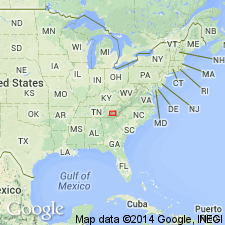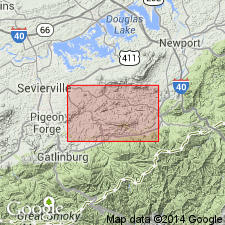
- Usage in publication:
-
- Dixon Mountain member*
- Modifications:
-
- Named
- Dominant lithology:
-
- Siltstone
- Sandstone
- AAPG geologic province:
-
- Appalachian basin
Summary:
Named as the lower member of Wilhite formation of Walden Creek group of Ocoee series. Named for Dixon Mountain, west of Jones Cove, Sevier Co., eastern TN. Consists mainly of micaceous and sandy siltstone containing carbonate concentrated along laminae. Contains some interbedded sandstone. Thickness about 1,500 ft. Underlies Yellow Breeches member of Wilhite. Age is later Precambrian.
Source: GNU records (USGS DDS-6; Reston GNULEX).

- Usage in publication:
-
- Dixon Mountain member*
- Modifications:
-
- Overview
- AAPG geologic province:
-
- Appalachian basin
Summary:
Dixon Mountain Member of Wilhite formation occupies much of central part of report area, including Bearwallow Mountain, Dixon Mountain, and Chestnut Ridge, as well as smaller areas near Dockery Branch and Chavis Creek. Best exposures are along Dunn Creek at east end of Short Mountain, Long Branch at east end of Dixon Mountain, and Chucky Creek at east end of Chestnut Ridge. Consists of a sequence of clastic rocks, mainly sandy siltstone, but including coarser beds on Chestnut Ridge assigned to member with some doubt. Rocks are the most resistant and well exposed of pelitic units. Thickness is about 1500 ft. Conformably underlies basal limestone bed of Yellow Breeches member of Wilhite formation; contact is exposed in small quarry south of junction between Valentine Branch and Dunn Creek; adjoins and probably overlies slate of Richardson Cove (upper member of Sandsuck formation) in eastern part of report area; although contact is not well defined. Also is in fault contact with Pigeon and Sandsuck formations; lithologic features are similar and prevent certainty of contacts. Age is late Precambrian. Report includes geologic map, cross sections, correlation chart, and measured sections.
Source: GNU records (USGS DDS-6; Reston GNULEX).
For more information, please contact Nancy Stamm, Geologic Names Committee Secretary.
Asterisk (*) indicates published by U.S. Geological Survey authors.
"No current usage" (†) implies that a name has been abandoned or has fallen into disuse. Former usage and, if known, replacement name given in parentheses ( ).
Slash (/) indicates name conflicts with nomenclatural guidelines (CSN, 1933; ACSN, 1961, 1970; NACSN, 1983, 2005, 2021). May be explained within brackets ([ ]).

